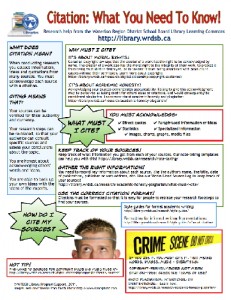Contents
- 1What does citing mean?
- 2Citing means that:
- 3When do you need to cite a source, and when is it not necessary?
- 4What is included in a citation, and why?
- 4.1A citation must make it easier for the audience to find the resource
- 4.2A citation demonstrates the quality of the resource
- 4.3A citation demonstrates the currency of the resource
- 4.4A citation gives credit where credit is due
- 5What if I don’t acknowledge my sources?
- 6How can I keep track of my sources?
- 7What is the correct way to cite sources?
What does citing mean?
When conducting research, you collect information, ideas and quotations from a variety of sources. You must acknowledge each source with a citation.
Citing means that:
- Your sources can be verified for their authority and currency
- Your research steps can be re-traced, so that your audience can consult specific sources and assess your conclusions about the topic
- You are honest about acknowledging other people’s words and ideas
- You are able to back up your own ideas with the words and ideas of the experts
When do you need to cite a source, and when is it not necessary?
You must acknowledge:
- Direct quotes
- Paraphrased information or ideas
- Specialized information
- Statistics
- Images, charts, graphs, media files
You don’t need to acknowledge, but may need to verify:
- Well-known dates (e.g., The armistice was signed on November 11, 1918)
- Simple definitions
- Commonly known facts (e.g., Paris is the capital of France)
What is included in a citation, and why?
A citation must make it easier for the audience to find the resource
Providing the author’s name, the title, publication date and publisher makes the resource easier to find. In the case of an online resource, recording the URL and the date viewed is important. How you account for this may vary, depending on the style guide you are using.
A citation demonstrates the quality of the resource
Information written by an acknowledged authority and published by a reputable institution or publisher has the most credibility.
A citation demonstrates the currency of the resource
Human knowledge changes over time, and our perspective also changes. A source that is current (published very recently), is more likely to be accurate and complete.
A citation gives credit where credit is due
Whoever wrote the book or article you are using put a lot of thinking and effort into it, and has developed expertise in their area. They deserve to be acknowledged.
What if I don’t acknowledge my sources?
Not acknowledging your sources means that you are representing others’ ideas as your own. This is dishonest: there is even a name for it – plagiarism. Find out more about plagiarism.
How can I keep track of my sources?
It is important to keep track of what information you got from what source. Using our note-taking templates will help you to do this. The Works Cited Source Log will help you to keep track of all of your sources for a project, and will also help to make sure that you collect all of the information required for a proper citation.
What is the correct way to cite sources?
There are several different methods of citing sources (ALA, MLA, etc.), depending on the topic and style of your research, and your teachers’ requirements. All methods require you to record basic information (like author, title, publisher, date and place of publication, etc.) as you research. Find out more about formatting citations in the Style Guides section of this website.

